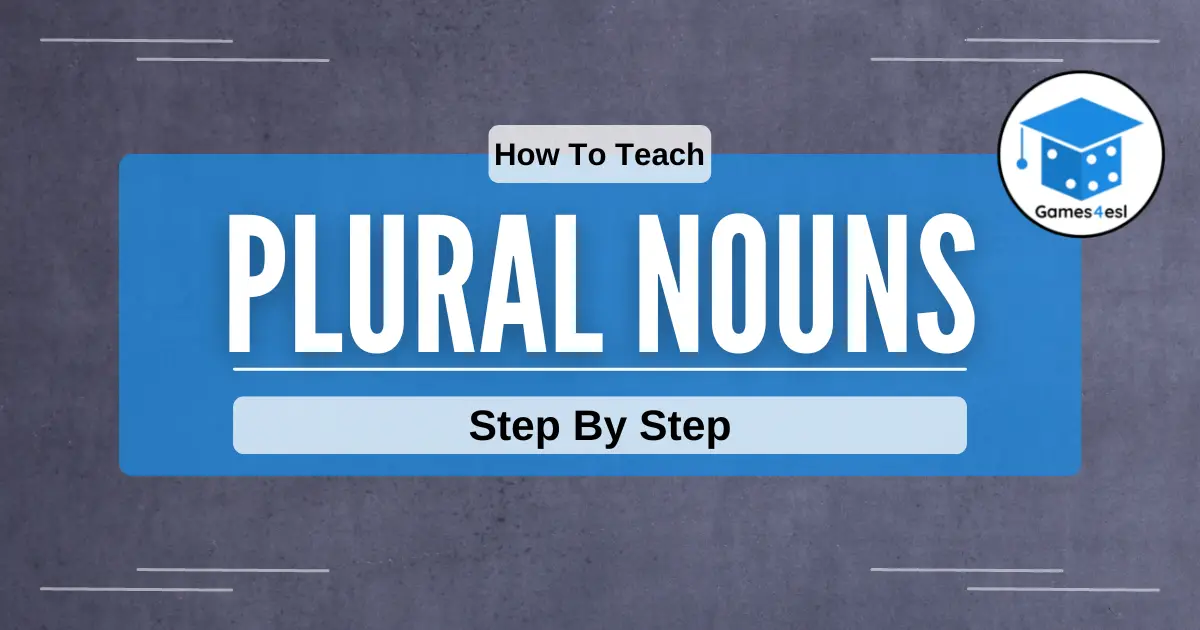How To Teach Plural Nouns | A Step By Step Guide
Teaching English plural nouns can be challenging! Not only are there several rules for forming plural nouns, there are also many irregular nouns that don’t follow these rules. This makes mastering plural nouns a rather tricky task for English language learners. In this guide, we will detail step by step how to teach plural nouns in a fun and effective way so that your students can understand and use plural nouns in no time! Let’s get started.
How To Teach Plural Nouns
Step 1: Introduce Plural Nouns In Context
Before students can learn how to form plural nouns, they first need to understand the concept of plurals. When teaching new concepts or grammar points to students, it’s always best to explain them in context. A great way to do this with plural nouns is to draw a simple building on the board and tell students it is your fruit and vegetable store.
Next, draw an apple in the store and say, “One apple.” and have students repeat after you. Ask students what other fruit/vegetables they know and draw them in the store. Once you have a few singular fruits/vegetables in the store, mime/draw to indicate that you have just received a delivery to your store. Now, instead of ‘one apple’ you have ‘three apples’; instead of ‘one carrot’ you have ‘five carrots’, etc.
Write the singular and plural forms of each of the fruit/vegetables on the board and practice saying them chorally as a class. For example, “one apple, two apples.“, “one cherry, two cherries“, etc. Once students have practiced enough and understand the concept of plurals, it’s time to show students how to form plural nouns.
Step 2: Introduce The Plural Noun Rules
While drawing attention to some of the plural forms that you already have on the board (apples, cherries, etc), explain to students the different rules on how to take a singular noun and change it into a plural noun. Here is a simple plural nouns rule chart you can draw on the board:
| Rule | Which Nouns? | Examples |
|---|---|---|
| add -s | regular nouns | cats, apples, pencils |
| add -es | nouns ending in -s, -ss, -sh, -ch, -x, -z | buses, lunches, taxes |
| add -ies | nouns ending in -y and the letter before -y is a consonant | cities, puppies, cherries |
If you’d rather not spend time drawing the rules table on the board, you can use this PowerPoint lesson on nouns which includes the plural noun rules and examples.
Step 3: Practice Forming Plural Nouns
As there are a few different ways to form plural nouns, students will need lots of practice. A great way to have students practice is to provide them with a list of nouns and have them change them into the plural form based on the rules table you have drawn on the board. If students are young or low-level, you may want to put students in pairs or small teams to do this.
You can do this exercise with any list of nouns, but if you want to stick to the fruit/vegetable theme we used in step 1, you can find a list of fruits and vegetables here.
Step 4: Play A Plural Nouns Game
If your teaching plural nouns to children, then playing a fun game is a great way to keep them interested and engaged. The above game has ten rounds, and in each round, students will see the outline of some fruits or vegetables. They then have 5 seconds to guess and answer, “What are these/those?“.
In each round, after students have guessed the answer, pause the video and elicit the singular and plural form of the noun and drill chorally with the whole class.
Step 5: Introduce Irregular Plural Nouns
Once students have had lots of practice with regular plural nouns, it’s important to let them know that some nouns are irregular and so do not follow the regular plural noun rules. To learn irregular plural nouns, students just have to memorize the words. Here is a list of some common irregular plural nouns:
- child – children
- person – people
- man – men
- woman – women
- sheep – sheep
- wolf – wolves
- knife – knives
- mouse – mice
- fish – fish
Step 6: Make Sentences With Plural Nouns
Finally, it’s time to teach students how to use plural nouns in sentences. You will likely do this over several lessons as you focus on different target expressions. For example, you might first teach a lesson on ‘this/that/these/those‘ together with plural nouns, and then teach a lesson on ‘How many?’ in which students will have to answer using plural nouns. As you work through these lessons, be sure to review the plural noun rules and highlight irregular plural nouns because students will need a lot of practice over many lessons to master plurals.
Related Resources
Thanks for reading! I hope you found this guide on how to teach plural nouns useful. Before you go, check out these related resources that you might also find useful:
Plural Nouns Quiz
Plural Noun Flashcards
Person Place Or Thing Quiz
List Of Countable And Uncountable Foods
These/Those Game


